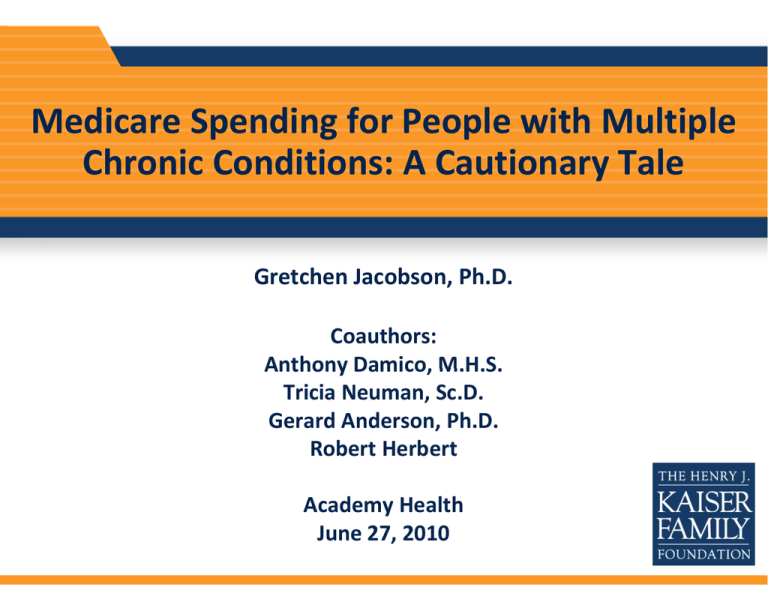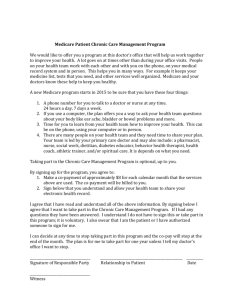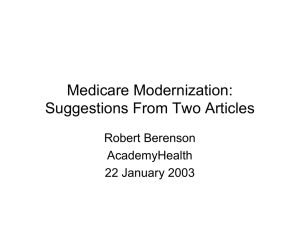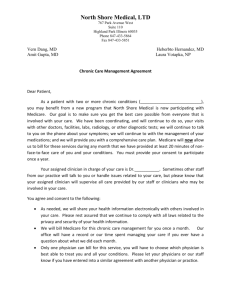Medicare Spending for People with Multiple Ch i C diti
advertisement

Medicare Spending for People with Multiple Ch i C diti Chronic Conditions: A Cautionary Tale A C ti T l Gretchen Jacobson, Ph.D. Coauthors: Anthony Damico M H S Anthony Damico, M.H.S. Tricia Neuman, Sc.D. Gerard Anderson, Ph.D. Robert Herbert Academy Health Academy Health June 27, 2010 EXHIBIT 2 Health Reform and Chronic Conditions: Key Provisions Medicare • Center for Medicare and Medicaid Innovation (Sec. 3021) • Demo that allows eligible Medicare beneficiaries, including those with 2 or more chronic conditions, to receive home‐based primary care (Sec. 3024) Medicaid • Federal funding for states to provide health homes to coordinate care for Medicaid enrollees with chronic conditions (Sec. 2703) • Grants to states to develop programs to help Medicaid enrollees stop smoking, lower pp g p p g, cholesterol, lower blood pressure, lose weight, or manage diabetes (Sec. 4108) Quality • Secretary required to develop quality measures for at least 10 acute and chronic Secretary required to develop quality measures for at least 10 acute and chronic conditions within 2 years (Sec. 3013, as modified by Sec. 10303) • New program to support medication management services for individuals with chronic conditions (Sec. 3503) conditions (Sec 3503) Other • Additional funds for provider education on chronic disease management (Sec 5305 5405 and 5509) (Sec. 5305, 5405, and 5509) • Additional councils, funds, and efforts to prevent chronic conditions (Sec. 4001, 4002, 4004, 4202) EXHIBIT 3 Previous Research on Medicare Spending for Chronic Conditions • Beneficiaries with chronic conditions account for a disproportionate share of Medicare spending1 Distribution of Fee‐For‐Service Medicare Beneficiaries Ages 65 and Older with 2 or More Ch i C diti Chronic Conditions and Medicare Spending, 2007 d M di S di 20071 6% 27% • Average Medicare spending increases with the number of chronic conditions1 94% 73% • Increased spending on chronic diseases is a key factor driving the overall growth in FFS Medicare g spending2 Total FFS Medicare beneficiaries, Total FFS Medicare spending ages 65+ SOURCES: 1 Anderson G. Chronic conditions: making the case for ongoing care. Baltimore: Johns Hopkins University, February 2010. 2 Thorpe KE, Ogden LL, and Galactionova K, “Chronic conditions account for rise in Medicare spending from 1987 to 2006,” Health Affairs (2010): 718‐724. EXHIBIT 4 Purpose and Methods Purpose: Estimate Medicare expenditures for all combinations of the 17 most common chronic conditions h i diti Data: Standard Analytic File (5% sample of Medicare claims), linked 2005‐2007 Part A and B data; not Part D (prescription drugs) No spending for beneficiaries in Medicare Advantage plans Includes institutional population; excludes ESRD Includes institutional population; excludes ESRD Methods: • Examines mean Medicare expenditures in 2007 for all combinations of the 17 most d d f ll b f h common chronic conditions • Identifies beneficiaries with chronic conditions as those with one of the conditions i 2005 2006 in 2005 or 2006 • Does not adjust for or exclude spending incurred by beneficiaries who died • Analysis based on descriptive data EXHIBIT 5 Medicare spending for beneficiaries with individual chronic conditions “exceeds” total Medicare FFS spending p g Share of Medicare FFS spending, 2007 450% 400% 10 Other Chronic Chronic Conditions 350% 300% 250% COPD (26%) COPD (26%) Arthritis (31%) Cataracts (31%) 200% 150% 100% 50% 0% Diabetes (34%) Ischemic Heart Disease (39%) Hyperlipidemia (58%) Hypertension (76%) EXHIBIT 6 Findings: Medicare per capita costs vary widely among beneficiaries in p g p, specific chronic condition groups, 2007 Average Medicare per capita costs $50,000 $47,089 $47,089 $40,000 – Mean Median $47,089 $47,089 $47,089 $37,467 $47,089 $37,050 $31,658 $30 000 $30,000 $20,000 $10,000 $0 $1,715 $2,766 $2,586 Hypertension Diabetes Arthritis $4,853 $4,408 $4,828 $1,723 Chronic Kidney Kidney Disease $1,715 Heart failure Alzheimer’s Depression Osteoporosis SOURCE: KFF/Johns Hopkins analysis of the Medicare Standard Analytic File, 2005‐2007. $3,148 COPD EXHIBIT 7 Findings: Average Medicare per capita costs increase by the number of yg y chronic conditions, but also vary greatly, 2007 Average Medicare per capita costs $40 000 $40,000 $35,000 – Mean Median 12% of beneficiaries with 4 chronic conditions have lower average Medicare spending than the average cost of beneficiaries with 2 chronic conditions $30,000 $26,782 $25,000 $22,214 $19 154 $19,154 $20,000 $15,000 $34,192 $11,432 , $10,000 $5,000 $0 $2,075 $1,723 $2,210 $1,715 $2,766 1 2 3 4 5 Number of Chronic Conditions NOTE: Chronic condition count includes the 17 most prevalent chronic conditions. Beneficiaries may have other conditions. SOURCE: KFF/Johns Hopkins analysis of the Medicare Standard Analytic File, 2005‐2007. EXHIBIT 8 Findings: No single combination of conditions that includes diabetes accounts for the majority of Medicare spending for beneficiaries with diabetes j y p g Other Medicare spending 66% Spending for beneficiaries with diabetes 34% All other combinations of conditions of conditions 92% Diabetes + Hypertension + Hyperlipidemia, 4% i b li id i % Diabetes + Hyperlipidemia, 1% Diabetes + Hypertension, 2% Diabetes only, 1% Total Medicare FFS spending for the study sample, 2007= $234 billion l 2007 $234 billi SOURCE: KFF / Johns Hopkins analysis of the Medicare Standard Analytic File, 2005‐2007. Total Medicare spending for beneficiaries with di b diabetes, in the study sample, 2007= i h d l 2007 $80 billion EXHIBIT 9 Findings: Similarly, no single combination of conditions that includes depression accounts for the majority of Medicare spending for beneficiaries with depression j y p g p Other Medicare spending 81% Spending for beneficiaries with beneficiaries with depression 19% All other combinations of conditions of conditions 92% Depression + Hypertension + Hyperlipidemia, 1% Depression + Hyperlipidemia, 1% i li id i % Depression + Hypertension, 2% Depression only, 4% Total Medicare FFS spending for the study sample, 2007= $234 billion l 2007 $234 billi SOURCE: KFF / Johns Hopkins analysis of the Medicare Standard Analytic File, 2005‐2007. Total Medicare spending for beneficiaries with d depression, in the study sample, 2007= i i h d l 2007 $43 billion EXHIBIT 10 Findings: Medicare spending for beneficiaries with COPD is also primarily for combination of conditions Other Medicare spending 74% Spending for beneficiaries with COPD 26% All other combinations of conditions of conditions 94% COPD + Hypertension + Hyperlipidemia, 1% COPD + Hyperlipidemia, 1% li id i % COPD + Hypertension, 2% COPD only, 2% Total Medicare FFS spending for the study sample, 2007= $234 billion l 2007 $234 billi SOURCE: KFF / Johns Hopkins analysis of the Medicare Standard Analytic File, 2005‐2007. Total Medicare spending for beneficiaries with COPD i h COPD, in the study sample, 2007= d l 2007 $60 billion EXHIBIT 11 Conclusions and Policy Implications • Efforts that target individuals based on a specific chronic disease, without attention to combinations of conditions, may be less successful in achieving cost and care outcomes • Eff Efforts that target individuals based on the number h i di id l b d h b of chronic conditions, f h i di i without attention to combinations of conditions, may be less successful in achieving cost and care outcomes • Health reform efforts to control the costs of chronic conditions may use resources inefficiently if they do not target specific combinations of conditions • Careful consideration should be given to tradeoffs related to per capita spending, prevalence, and the viability of interventions to reduce spending, prevalence, and the viability of interventions to reduce spending • Future research should explore additional ways of identifying high cost combinations of conditions that are ripe for interventions



